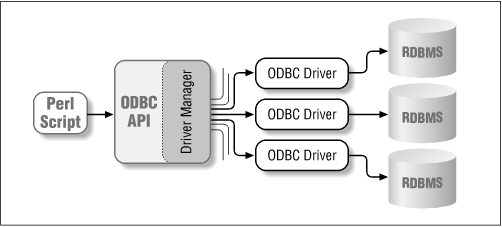
Chapter 7. ODBC and the DBI
Contents:
ODBC -- Embraced and Extended
DBI -- Thrashed and Mutated
The Nuts and Bolts of ODBC
ODBC from Perl
The Marriage of DBI and ODBC
Questions and Choices
Moving Between Win32::ODBC and the DBI
And What About ADO?
Open Database Connectivity, commonly known as ODBC , defines a database-independent API. The ODBC Driver Manager supports the API and manages one or more plug-in drivers for talking to different types of databases. The architecture is shown in Figure 7-1.

Figure 7-1. The ODBC architecture
Doesn't this all sound rather familiar? The ODBC driver manager and drivers are doing just what the DBI and its drivers are doing: defining and implementing a database-independent, application-programming interface.
This leads us to a whole bunch of questions: What's the difference? Why not just use ODBC and not the DBI? Can the DBI and ODBC work together? What advantages does one have over the other?
Before we try to answer those questions, let's get some perspective by looking into the history and goals of ODBC and the DBI, and take a look at the Win32::ODBC module, which implements a direct interface to ODBC for Perl.
7.1. ODBC -- Embraced and Extended
In the early 1990s, a consortium of vendors formed the SQL Access Group to support SQL interoperability across disparate systems. In October 1992 and October 1993, a major part of that work was published as a draft standard entitled "Call Level Interface," or CLI, which is another name for an Application Programing Interface, or API. However, the SQL Access Group CLI standard never really took off. At least, not in that form.
Microsoft needed to implement a similar concept, to avoid having to release multiple versions of any product that needed to talk to multiple databases. They saw the SQL Access Group CLI standard and ``embraced and extended'' it, radically. The result was the Open Database Connectivity interface, which rapidly became a de facto standard. In fairness, Microsoft turned an incomplete paper standard into a fully featured practical reality.

Copyright © 2001 O'Reilly & Associates. All rights reserved.



